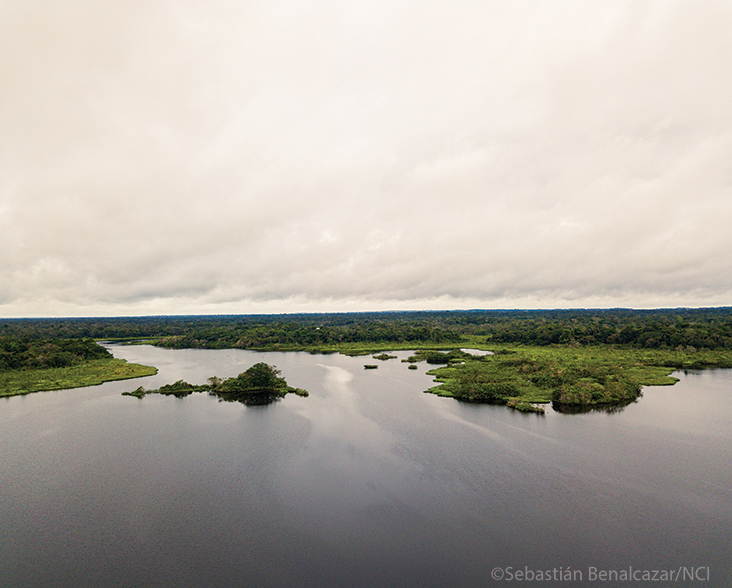Amazon River Dolphin
Species Data
Class: Mammalia
Order: Artiodactyla
Family: Iniidae
Scientific Name: Inia geoffrensis
IUCN Red List status: Endangered
Description
The world’s most abundant and well-known freshwater cetacean, the Amazon River Dolphin or Pink Dolphin, known in Brazil as the Boto, is found in just three river basins in South America.
A distinctive species adapted to navigate riverine habitats, it has a long, flexible body, including non-fused neck vertebrae allowing it to turn its head in all directions, a small head with protruding cheeks and a soft, bulbous melon, small eyes, and a long, narrow beak containing 24-35 pairs of teeth in the upper and lower jaw. Vertical pleats on the throat allow for the swallowing of large prey. The broad, triangular, paddle-like pectoral fins have a scalloped rear edge and a flexible joint; the dorsal fin is low, rounded and thick, with a long base, and the tail fluke is broad.
Body colour changes with age from dark grey in newborns, then pale grey in young animals, to grey with pink or white on the flanks and ventral surface in mature individuals, with the dorsal surface usually darker than the ventral surface. Males are generally much more pink than females.
The Amazon River Dolphin is the largest freshwater dolphin species. Adult females are typically 182-218 cm, while males measure 16% more at 219-249 cm, with the longest male reaching 250 cm. Males are also around 55% heavier than females, tipping the scales at around 180 kg, with non-pregnant females weighing up to 120 kg. Newborn calves are 78-90 cm long and weigh 12 kg. Males can live for up to 36 years, and females for at least 32 years.
Behaviour
Amazon River Dolphins are mostly crepuscular but remain active throughout the day and night. Although they have good vision above and below water, they mainly use echolocation to navigate and find prey in the dark, turbid river waters filled with branches, trunks, aquatic plants and suspended material.
Much of their diet consists of fish, with over 50 prey species recorded. Fish are caught with their anterior teeth and crushed by the posterior teeth before being swallowed head first. Larger fish are torn apart before they are eaten. During the high-water season, fish disperse into flooded areas and become more difficult to find and catch, so a wider variety of prey is taken, including molluscs, freshwater crabs, and small turtles.
Amazon River Dolphins are solitary or found in small pods of 3-4 individuals and only occasionally form large groups. They communicate by producing a variety of sounds, such as single intense clicks, jaw-snaps, burst-pulses, and whistles. The specific function of these sounds is uncertain, but some pulse calls are thought to be related to foraging and mother-calf contact calls. Behaviour of adult males associated with courtship and mating includes repeatedly carrying and throwing objects such as sticks, branches and clumps of grass at the surface.
During the high-water season, solitary males prefer to remain in the main river channels, whereas females and calves move into flooded areas. Calving can occur throughout the year but peaks when water levels are lowest and fish easier to catch. After a gestation period of 12-13 months, females give birth to a single calf that may remain with their mother for 1.5-5.8 years. Females become sexually mature at around ten years old and spend most of their lives with dependent young. As a result, they are often lactating when pregnant.


Habitat
Although distributed across Bolivia, Brazil, Colombia, Ecuador, Peru and Venezuela, the Amazon River Dolphin is found only in the Amazon, Orinoco and Madeira River basins, with each population comprising a different subspecies.
This species inhabits riverine habitats, including major rivers, tributaries, smaller channels, confluences, bays, lagoons, lakes and flooded forests, preferring areas with a low current, such as confluences and close to river banks. Amazon River Dolphins frequently show strong site fidelity, with individuals recorded in the same area for over 25 years.
The use of these habitats is determined by the annual flood pulses. During low-water seasons, Amazon River Dolphins are restricted to the main rivers, deep lakes and channels. But when flood water is high, they follow the movement of their prey into flooded forests and grasslands.
Threats and Conservation
Although there are no range-wide estimates of abundance or population trends, the Amazon River Dolphin is still abundant and widely distributed. However, surveys in the Brazilian Amazon estimate an average decline of 6.7% per year in the population here due to a rapidly expanding Piracatinga fishery that intentionally hunts Amazon River Dolphins for bait, killing an estimated 300-4,000 animals per year.
The construction of hydroelectric dams has an enormous impact on the Amazon River Dolphin’s environment, altering the flood pulse of rivers, blocking the movement of fish, fragmenting and isolating dolphin populations, and possibly increasing concentrations of parasites in dolphins and fish. Other threats include the siltation of rivers due to agricultural practices, entanglement in nylon gillnets and seine nets, the dumping of mercury into waterways, and toxins released by algae during high water temperatures. Therefore, since 2018, the Amazon River Dolphin has been categorised as Endangered on the IUCN Red List.
